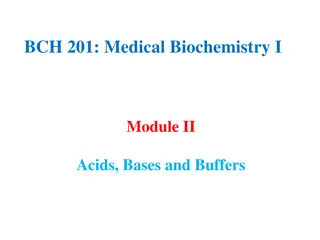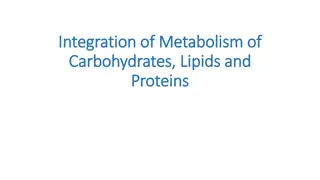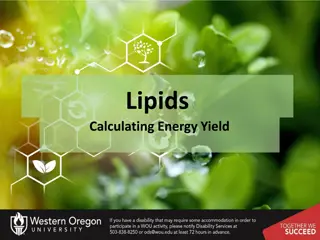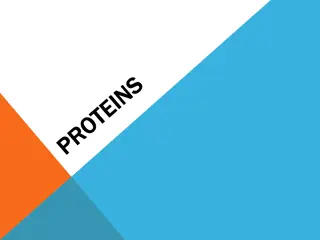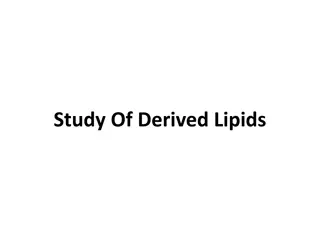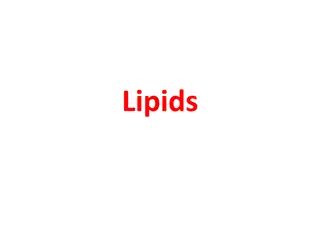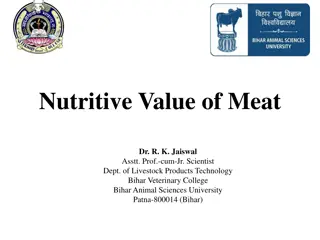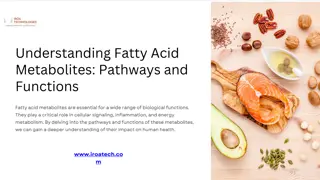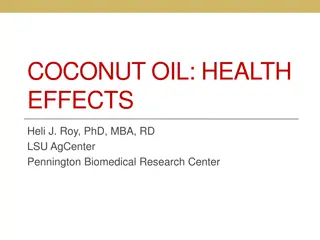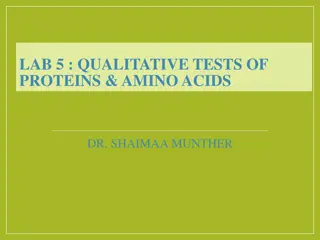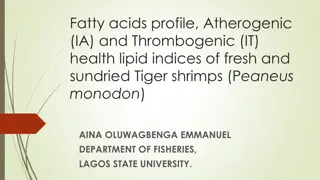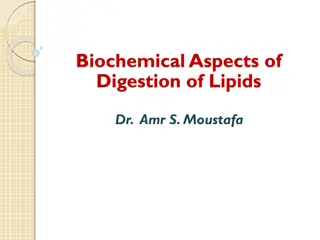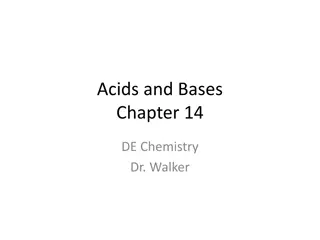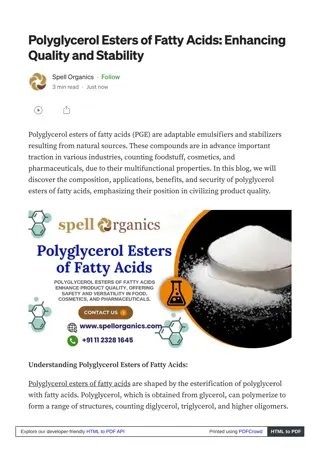Lipid Metabolism and Fatty Acids Overview
Lipids, defined by low water solubility, play vital roles in energy storage and membrane formation. Fatty acids, with saturated or unsaturated bonds, are key components of lipids in biological systems. This overview delves into the structure, nomenclature, and examples of common fatty acids, highlighting their diverse roles and importance in metabolism.
Download Presentation

Please find below an Image/Link to download the presentation.
The content on the website is provided AS IS for your information and personal use only. It may not be sold, licensed, or shared on other websites without obtaining consent from the author.If you encounter any issues during the download, it is possible that the publisher has removed the file from their server.
You are allowed to download the files provided on this website for personal or commercial use, subject to the condition that they are used lawfully. All files are the property of their respective owners.
The content on the website is provided AS IS for your information and personal use only. It may not be sold, licensed, or shared on other websites without obtaining consent from the author.
E N D
Presentation Transcript
Metabolism of Lipids (BCH303) Dr. R.N.Ugbaja Lipids are a class of biological molecules defined by low solubility in water and high solubility in nonpolar solvents. As molecules that are largely hydrocarbon in nature, lipids represent highly reduced forms of carbon and, upon oxidation in metabolism, yield large amounts of energy. Lipids are thus themolecules of choice for metabolic energy storage. The lipids found in biological systems are either hydrophobic (containing only nonpolar groups) or amphipathic, which means they possess both polar and nonpolar groups. The hydrophobic nature of lipid molecules allows membranes to act as effective barriers to more polar molecules. Fatty Acids A fatty acid is composed of a long hydrocarbon chain ( tail ) and a terminal carboxyl group (or head ). The carboxyl group is normally ionized under physiological conditions. Fatty acids occur in large amounts in biological systems,but rarely in the free, uncomplexed state. They typically are esterified to glycerol or other backbone structures. Most of the fatty acids found in nature have an even number of carbon atoms (usually 14 to 24). Certain marine organisms, however, contain substantial amounts of fatty acids with odd numbers of carbon atoms. Fatty acids are either saturated (all carbon carbon bonds are single bonds) or unsaturated (with one or more double bonds in the hydrocarbon chain). If a fatty acid has a single double bond, it is said to be monounsaturated, and if it has more than one, polyunsaturated. Fatty acids can be named or described in at least three ways, as listed in the Table below. The systematic name for a fatty acid is derived from the name of its parent hydrocarbon by the substitution of oic for the final e. For example, the C18 saturated fatty acid is called octadecanoicacid because the parent hydrocarbon is octadecane. A C18 fatty acid with one double bond is called octadecenoic acid; with two double bonds, octadecadienoic acid; and with three double bonds, octadecatrienoic acid. The notation 18:0 denotes a C18 fatty acid with no double bonds, whereas 18:2 signifies that there are two double bonds. The structures of the ionized forms of two common fatty acids palmitic acid (C16, saturated) and oleic acid (C18, monounsaturated) are shown in Figure below. .
They are numbered starting at the carboxyl terminus, as shown in the margin. Carbon atoms 2 and 3 are often referred to as a and b, respectively. The methyl carbon atom at the distal end of the chain is called the w- carbon atom. Alternatively, the position of a double bond can be denoted by counting from the distal end, with the w-carbon atom (the methyl carbon) as number 1. An w-3 fatty acid, for example, has the structure shown in the margin. Table showing some Common Biological Fatty Acids Number of Carbons Common Name Systematic Name Symbol Structure Saturated fatty acids 12 Lauric acid Dodecanoic acid 12:0 CH3(CH2)10COOH 14 Myristic acid Tetradecanoic acid 14:0 CH3(CH2)12COOH 16 Palmitic acid Hexadecanoic acid 16:0 CH3(CH2)14COOH 18 Stearic acid Octadecanoic acid 18:0 CH3(CH2)16COOH 20 Arachidic acid Eicosanoic acid 20:0 CH3(CH2)18COOH 22 Behenic acid Docosanoic acid 22:0 CH3(CH2)20COOH 24 Lignoceric acid Tetracosanoic acid 24:0 CH3(CH2)22COOH Unsaturated fatty acids (all double bonds are cis) 16 Palmitoleic acid 9-Hexadecenoic acid 16:1 CH3(CH2)5CH=CH(CH2)7COOH 18 Oleic acid 9-Octadecenoic acid 18:1 CH3(CH2)7CH=CH(CH2)7COOH 18 Linoleic acid 9,12-Octadecadienoic acid 18:2 CH3(CH2)4(CH=CHCH2)2(CH2)6COOH 18 -Linolenic acid 9,12,15-Octadecatrienoic acid 18:3 CH3CH2(CH=CHCH2)3(CH2)6COOH 18 -Linolenic acid 6,9,12-Octadecatrienoic acid 18:3 CH3(CH2)4(CH=CHCH2)3(CH2)3COOH 20 Arachidonic acid 5,8,11,14-Eicosatetraenoic acid 20:4 CH3(CH2)4(CH=CHCH2)4(CH2)2COOH 24 Nervonic acid 15-Tetracosenoic acid 24:1 CH3(CH2)7CH=CH(CH2)13COOH
Unsaturated fatty acids are slightly more abundant in nature than saturated fatty acids, especially in higher plants. The most common unsaturated fatty acid is oleic acid, or 18:1(9), with the number in parentheses indicating that the double bond is between carbons 9 and 10. The number of double bonds in an unsaturated fatty acid varies typically from one to four, but, in the fatty acids found in most bacteria, this number rarely exceeds one. The double bonds found in fatty acids are nearly always in the cis configuration. As shown in Figure below, this causes a bend or kink in the fatty acid chain. This bend has very important consequences for the structure of biological membranes. Saturated fatty acid chains can pack closely together to form ordered, rigid arrays under certain conditions, but unsaturated fatty acids prevent such close packing and produce flexible, fluid aggregates. Some fatty acids are not synthesized by mammals and yet are necessary for normal growth and life. These essential fatty acids include linoleic and -linolenic acids. These must be obtained by mammals in their diet (specifically from plant sources). Arachidonic acid, which is not found in plants, can only be synthesized by mammals from linoleic acid. At least one function of the essential fattyacids is to serve as a precursor for the synthesis of eicosanoids, such as prostaglandins, a class of compounds that exert hormone-like effects in many physiological processes. In addition to unsaturated fatty acids, several other modified fatty acids are found in nature. Microorganisms, for example, often contain branched-chain fatty acids, such as tuberculostearic acid. When these fatty acids are incorporated in membranes, the methyl group constitutes a local structural perturbation in a manner similar to the double bonds in unsaturated fatty acids. Some bacteria also synthesize fatty acids containing cyclic structures such as cyclopropane, cyclopropene, and even cyclopentane rings. The properties of fatty acids and of lipids derived from them are markedly dependent on chain length and degree of saturation. Unsaturated fatty acids have lower melting points than saturated fatty acids of the same length. For example, the melting point of stearic acid is 69.6 C, whereas that of oleic acid (which contains one cis double bond) is 13.4 C. The melting points of polyunsaturated fatty acids of the C18 series are even lower. Chain length also affects the melting point, as illustrated by the fact that the melting temperature of palmitic acid (C16) is 6.5 degrees lower than that of stearic acid (C18). Thus, short chain length and unsaturation enhance the fluidity of fatty acids and of their derivatives
Fatty Acids in Food: Saturated Versus Unsaturated Fats consumed in the modern human diet vary widely in their fatty acid compositions. The table below provides a brief summary. The incidence of cardiovascular disease is correlated with diets high in saturated fatty acids. By contrast, a diet that is relatively higher in unsaturated fatty acids (especially polyunsaturated fatty acids) may reduce the risk of heart attacks and strokes. Corn oil, abundant in the United States and high in (polyunsaturated) linoleic acid, is an attractive dietary choice. Margarine made from corn, safflower, or sunflower oils is much lower in saturated fatty acids than is butter, which is made from milk fat. However, margarine may present its own health risks. Its fatty acids contain trans-double bonds (introduced by the hydrogenation process), which may also contribute to cardiovascular disease. Although vegetable oils usually contain a higher proportion of unsaturated fatty acids than do animal oils and fats, several plant oils are actually high in saturated fats. Palm oil is low in polyunsaturated fatty acids and particularly high in (saturated) palmitic acid (whence the name palmitic). Coconut oil is particularly high in lauric and myristic acids (both saturated) and contains very few unsaturated fatty acids. Some of the fatty acids found in the diets of developed nations (often 1 to 10 g of daily fatty acid intake) are trans fatty acids fatty acids with one or more double bonds in the trans configuration. Some of these derive from dairy fat and ruminant meats, but the bulk are provided by partially hydrogenated vegetable or fish oils. Substantial evidence now exists to indicate that trans fatty acids may have deleterious health consequences. Numerous studies have shown that trans fatty acids raise plasma LDL cholesterol levels when exchanged for cis- unsaturated fatty acids in the diet and may also lower HDL cholesterol levels and raise triglyceride levels. The effects of trans fatty acids on LDL, HDL, and cholesterol levels are similar to those of saturated fatty acids, and diets aimed at reducing the risk of coronary heart disease should be low in both transand saturated fatty acids. Triacylglycerols A significant number of the fatty acids in plants and animals exist in the form of triacylglycerols (also called triglycerides). Triacylglycerols are a major energy reserve and the principal neutral derivatives of glycerol found in animals. These molecules consist of a glycerol esterified with three fatty acids.
CH2 CH CH2 RCOOH OH OH OH Glycerol Fatty acid CH2OCOOR1 CHOCOOR2 CH2OCOOR3 Triacylglycerol If all three fatty acid groups are the same, the molecule is called a simple triacylglycerol. Examples include tristearoylglycerol (common name tristearin) and trioleoylglycerol (triolein). Mixed triacylglycerolscontain two or three different fatty acids. Triacylglycerolsin animals are found primarily in the adipose tissue (body fat), which serves as a depot or storage site for lipids. Monoacylglycerolsand diacylglycerolsalso exist, but are far less common than the triacylglycerols. Most natural plant and animal fat is composed of mixtures of simple and mixed triacylglycerols. Acylglycerolscan be hydrolyzed by heating with acid or base or by treatment with lipases. Hydrolysis with alkali is called saponification and yields salts of free fatty acids and glycerol. This is how soap (a metal salt of an acid derived from fat) was made by our ancestors. One method used potassium hydroxide (potash) leached from wood ashes to hydrolyze animal fat (mostly triacylglycerols). (The tendency of such soaps to be precipitated by Mg and Ca ions in hard water makes them less useful than modern detergents.) When the fatty acids esterified at the first and third carbons of glycerol are different, the second carbon is asymmetric. The various acylglycerolsare normally soluble in benzene, chloroform, ether, and hot ethanol. Although triacylglycerolsare insoluble in water, mono-and diacylglycerolsreadily form organized structures in water (discussed later), owing to the polarity of their free hydroxyl groups. Triacylglycerolsare rich in highly reduced carbons and thus yield large amounts of energy in the oxidative reactions of metabolism. Complete oxidation of 1 g of triacylglycerolsyields about 38 kJ of energy, whereas proteins and carbohydrates yield only about 17 kJ/g. Also, their hydrophobic nature allows them to aggregate in highly anhydrous forms, whereas polysaccharides and proteins are highly hydrated. For these reasons, triacylglycerolsare the molecules of choice for energy storage in animals. Body fat (mainly triacylglycerols) also provides good insulation.


